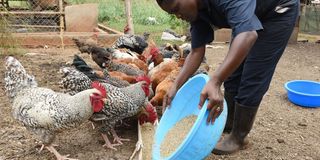What’s in a name? Animal feed standoff proves a lot

URA is set to start imposing Value Added Tax (VAT) and import duty on animal feeds. Photo/file
What you need to know:
- Concentrate has been an 11-word noun and more after the taxman made clear plans to tax animal feed concentrates. In this explainer, Juliet Najjinda peels back the layers on the standoff.
The mainstream media has been awash with commentaries on the implications of the recent directive by the Uganda Revenue Authority (URA) to start imposing Value Added Tax (VAT) and import duty on animal feeds that are imported into Uganda in the form of concentrates. The implications of the proposed changes to taxpayers are in a sense varied.
What has changed in the aftermath of the taxman’s communication that a tax is going to be brought in for certain components of animal feeds?
URA has communicated that they are going to start taxing animal feeds that are imported into Uganda in the form of concentrates. This is based on the premise that concentrates are not specifically listed among the exempt items in the VAT Act or the items that attract import duty at a zero rate under the East African Community (EAC) Common External Tariff handbook.
Currently, animal feeds and premixes are listed in the VAT Act among the items that are exempt from VAT. This exemption was introduced by the government with effect from July 1, 2017, in order to make such feeds cheaper as a way of promoting the agricultural industry. Elsewhere, premixes that are imported into Uganda are not subject to import duty (attract a zero rate of import duty).
How are taxpayers expected to draw a distinction between animal feeds and premixes that are exempt from taxes yet concentrates also form part of animal feeds?
There are no clear guidelines within the tax laws on the determination of what premixes or concentrates are. The absence of a definition of these terms in the Acts means that taxpayers and the taxman have to rely on the literal/dictionary meaning of these terms as well as their chemical composition. Where there exist legal precedents in form of case law, then the precedent in question may also be relied on in determining the meaning of these words.
On the one hand, premixes generally consist of vitamins, minerals and pharmaceutical additives—which ordinarily do not form more than four percent composition of the animal feeds. On the other hand, concentrates are composed of premix and protein feeds. Generally, between 10 percent to 30 percent of concentrates are added to animal feeds and are then mixed with corn, bran, etc.
Based on the above literal descriptions, it remains unclear to importers of these products, the clearing agents as well as the customs officers as to how to draw a distinction between the premixes that are not subject to import duty and the concentrates, especially since premixes appear to be a component of concentrates. It also remains unclear why concentrates should not qualify as a constituent of animal feeds that are exempt from VAT.
Accordingly, it would be prudent for the government to provide guidance on the description of the various animal feed components that the exemptions are intended to cover. The guidance may be provided by way of amending the tax laws to include these definitions or issuance of a public notice by the Commissioner General of the URA.
What does this proposed change mean for taxpayers who have been importing these concentrates?
One of the general rules of statutory interpretation is that where there’s ambiguity in a tax law, then the particular tax clause should be interpreted in favour of the taxpayer. This implies that in the period where taxpayers did not have clarity on the distinction between premixes and concentrates, then the tax law should work in the taxpayer’s favour.
Separately, where the government comes out and clarifies that concentrates are distinctive from animal feeds or premixes on which VAT and import duty should apply, then the application cannot be retrospective. This is another rule of statutory interpretation. Accordingly, URA should not seek to enforce a retrospective application of this tax.
What will be the impact on farmers?
The government exempted feeds and premixes as raw materials used in the production of animal feeds as a way of supporting the agricultural sector through providing access to affordable feeds and to build capacity in this sector.
The introduction of VAT and import duty on the concentrates, which also form part of raw materials used in production of animal feed, implies that the cost of feeds is going to go up. This may jeopardise the government’s intention to build capacity in the agricultural sector.




